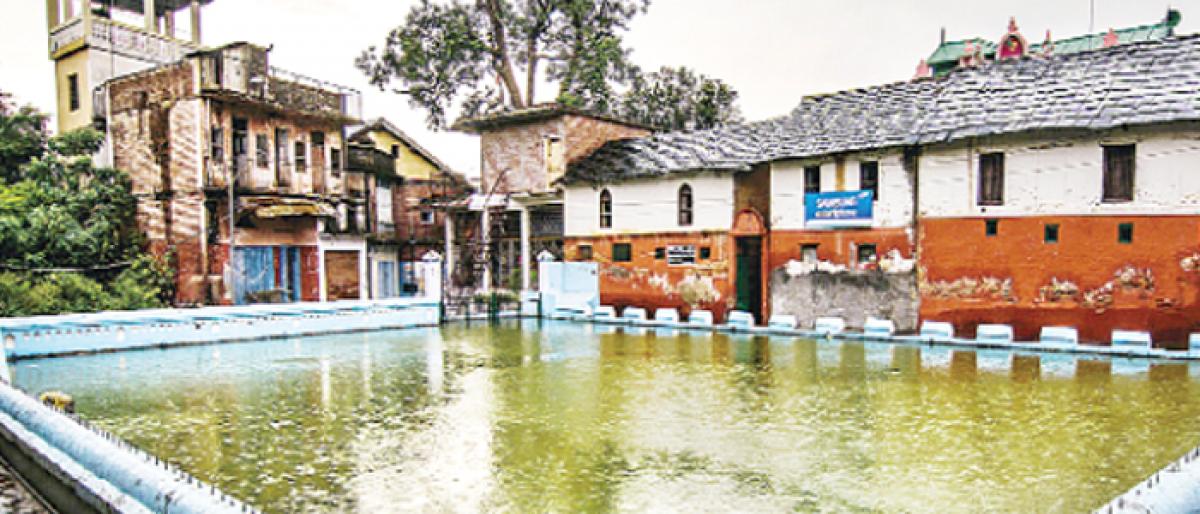Enveloped in an earlier era

In the shadow of the pristine white Dhauladhar ranges, nestles a quaint little time wrapped village As we walked through the cobbled streets, there was a feeling of retracing our steps to an earlier era, when life was more of a journey undertaken at a leisurely pace, with ample time to pause and experience the simple little pleasures of everyday living
In the shadow of the pristine white Dhauladhar ranges, nestles a quaint little time wrapped village. As we walked through the cobbled streets, there was a feeling of retracing our steps to an earlier era, when life was more of a journey undertaken at a leisurely pace, with ample time to pause and experience the simple little pleasures of everyday living.
Sloping roofs of blue-black slate sat atop mud plastered lime washed walls adorned with Rajasthani haveli style ornate windows. Basically, a one-horse town, a meandering well-maintained cobbled street leads to an ornamental ancient (150-year-old) village tank, which is still the hub of social life here.
The picturesque village of Pragpur dating back to the 16th century was founded by the prosperous Kuthiala Soods, who wanted to find a suitable place to commemorate Princess Prag of their royal lineage. The Soods are a special community, who claim to be Agnivanshis - born of a sacred fire. There are also references to them in ancient Hindu texts like the Rig Veda. The settlement of Pragpur is so located as to receive the astral benefic influence of prayers offered since thousands of years at three Shakti Temples (Kangra, Jwalamukhi and Chintpurni) located in the vicinity of the village.
During the period when Shimla was the summer capital of the British Raj, the Soods of Pragpur prospered a lot. Even today, they continue to be the dominant community here. Over a period of time, they travelled abroad and returned home to build mansions, hospitals and schools in similar architectural styles as they had observed during their travels. And that’s why, Pragpur, in spite of being situated in an obscure part of Himachal Pradesh, has houses in extremely diverse architectural styles — Kangra, Rajput, British, Portuguese and even Italian.
Lovingly restored over several years, the mansions of Pragpur form the chief attractions of the place. Set amidst expansive acreage replete with mango and litchi orchards, many of the mansions have beautifully carved wooden doors and intricate metalwork on railings in addition to fancy tile-work, ornamental towers and stained-glass windows. The expansive interiors are furnished with colonial-era furniture and paintings and boast of antique collections that include rare books and etched glass objects.
The core area of Pragpur has been notified by the Government as a ‘Heritage Village’ since December 9, 1997, thereby earning it the prestigious tag of India's first 'Heritage Village'. The ambience of the heritage zone is zealously protected by the local residents. The Pragpur village committee, which has been recording its meeting since 1864 is responsible for the maintenance of the heritage buildings and ancient water systems.
Any new construction taking place in the village must be ratified by the committee and construction takes place only if they approve of it! A specific colour code is followed, and all buildings need to be consistent with the medieval ambience of the village. In their endeavour that Pragpur retains its unique character, several heritage structures have been restored using original techniques but with modern facilities to facilitate tourists. This ensures that the village’s architecture stays the same and does not lose its charm.
We spent many pleasant hours strolling and discovering the mansions in the core heritage area. The Kuthiala complex buildings are the oldest; the Chaujjad Haveli has a lovely façade with ornamental arches; the 175 years old Butail Niwas epitomises the grandeur of community architecture, while the 150-year-old Banta Dwar has a red façade with painted flowers and wrought iron railings. Many of the mansions are made of the once-famous delicate Nanak-shahi bricks — small, slim, bricks baked in wood.
A network of cobblestoned alleys runs through the village, lending it a special charm. A cobbled lane winds through sleepy lanes and leads to the ornamental water tank called Taal. Built before 1868, the Taal is said to form the core of the village and is surrounded by several old community structures.
The village market also starts here. A short walk from the market takes us to a remarkable house with rooms constructed around a sunken central courtyard. This sunken courtyard was filled with water during the summer to provide a natural cooling system for the entire haveli.
Tourism promotion is a key factor, but at the same time, it is important to ensure that the place does not lose its charisma and uniqueness while providing employment to locals. Thankfully in Pragpur, urbanization has been unable to destroy the natural beauty of the place! The inhabitants of Pragpur are mostly practitioners of art and craft. A trip to this place automatically prompts a shopping spree as one walk past silversmiths, painters, basket makers, weavers, etc.
With its unique ambience and medieval age architecture, Pragpur truly deserves its “Heritage Village” tag. It actually offers what most so-called dream destinations generously promise but mostly fall short of delivering - the simple, charming, authentic recreation of the life of a bygone era.
Pragpur is an excellent example that heritage, even if surrounded by a sea of modernity, can successfully withstand the test of time, provided it is able to garner the right kind of patronisation.

